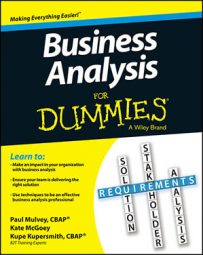As the business analyst, you’re charged with finding out how well each stakeholder is completing his job and how well his needs are being met so that he can do his job. After all, each stakeholder — department, group, or leader — has a specific part to play that’s in line with a company’s corporate mission: Deliver effective operations, enable innovations and creative problem-solving, or provide valuable products and services.
If stakeholders are having challenges playing their parts effectively, you’re responsible for finding out specifically what they’re trying to accomplish and what’s preventing them from doing that effectively. You must know what their specific tactical or operational goals, problems, and needs are. These stakeholder needs come to light when you focus on what the stakeholders are trying to achieve operationally and what they can’t easily or effectively achieve (and why).
How to identify what stakeholders need in your business analysis
The easiest and best place to start when discovering stakeholder needs is with their primary, bottom-line job(s). Find out what their objectives and responsibilities are — in other words, what do they need to do? Are they doing it? Is it going well? Are they achieving what they’re expected to? If not, what’s not going well? What are they having trouble with?
Find out how they can tell whether they’re meeting their goals. Do they measure something to find out for sure? Use the same approach to discover stakeholder needs as you do to discover business needs: Just ask the right questions.
What are the stakeholders’ roles, goals, mission, and vision for the future?
Are they on track? Do they have milestones or deadlines that they’re trying to meet or beat? Are they following certain processes or procedures to get there?
What tools or resources do they use, and what don’t they have that would help them do their work better, more quickly, or more cheaply? Why don’t they have those things? What have they found that’s effective, and what issues or concerns are in their way?
If they’re using software solutions as part of their work, what are their user goals (the reasons they interact with the software)? Are their user goals being met? Does the software hinder them or help them?
Dig into stakeholders’ day-to-day events; evaluate their typical processes, identify their end-products and outputs, and look at the inputs they get from others in the first place. See what’s sufficient and streamlined, and question inconsistency and repetition.
How to understand how stakeholders work together for your business analysis
After you have stakeholders’ specific work identified, you also need to consider stakeholder intersections or interfaces, the points at which groups cross paths or individuals interact with other groups. Organizations sometimes share files or information and collaborate on processes to deliver products or results. These situations may be efficient, or different factors may create frustration. Here are some important questions to ask when exploring how groups cross paths:
What requirements are others throwing at a given group, and how do those affect its ability to perform?
What specific guidelines, regulations, or interfaces does it have to deal with, deliver, or meet? Is it integrated effectively for collaboration where it needs to be?
What gaps does it have? Is it missing processes, people, or technology? What manual hoops does it have to jump through to get information passed back and forth?
Has it noticed any inefficiencies it wants fixed? What does it need, or what could it be doing differently that would enable it to achieve its goals?

